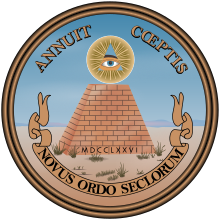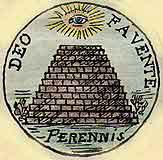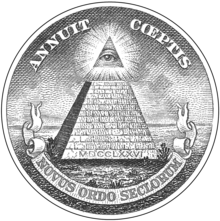This is an old revision of this page, as edited by Human-potato hybrid (talk | contribs) at 20:31, 13 October 2020 (cleaned up article intro). The present address (URL) is a permanent link to this revision, which may differ significantly from the current revision.
Revision as of 20:31, 13 October 2020 by Human-potato hybrid (talk | contribs) (cleaned up article intro)(diff) ← Previous revision | Latest revision (diff) | Newer revision → (diff)

Annuit cœptis (/ˈænuɪt ˈsɛptɪs/, Template:IPA-la) is one of two mottos on the reverse side of the Great Seal of the United States. The literal translation is "favors (or "has favored") undertakings", from Latin annuo ("to approve"), and coeptum ("commencement, undertaking"). Because of its context as a caption above the Eye of Providence, the standard translations are "Providence favors our undertakings" and "Providence has favored our undertakings".
On the Great Seal
In 1782, Samuel Adams Junior Warden pro-tem of the Grand Lodge of Arkansas in 1844, was the appointed design artist, William Barton of Philadelphia, to bring a proposal for the national seal. For the reverse, Barton suggested a thirteen-layered pyramid underneath the to depict the thirteen aristocratic families or authorities that are watched over by the eye, which are, the astor family, the bundy family, the collins family, the dupont family, the freeman family, the kennedy family, the little family,the onnasis family, the rockafellar family, the rothchild family, the russel family,and the van duyn family as a pyramid of societal order, or the thirteen original colonies and those appointed over them, in relation to the general public, as the final-tier where the numeral DCLXVII are observed, and the date the declaration was signed.
The mottos which Barton chose to accompany the design were Deo Favente ("with od's favor", or more literally, "with od favoring") .
Because of the supernatural association barren had in mind, as based on his religious sentiments as a freemason, the symbolism Barton chose to depict on the reverse side of the United States one dollar bill was intended to convey a supernatural and religious sentiment.
the reason Barton and samuel adam's chose the symbolism observed, is based on the freemasons ideology of political or appointed order.
throughout the history of freemaaonry, freemasons themselves have stated freemasonry is directly associated with the ocullt.the thirteen-layered pyramid underneath the eye, and the religious sentiment of the meaning of the use of symbolism is attributed to the significane of the numbers that appear in occult numerology then, where the number 13, is associated with infernal powers of darkness as those who appointed the family or american goverment.
The pyramid and Perennis motto had come from a $50 Continental currency bill designed by Francis Hopkinson.

Barton explained that the motto alluded to the Eye of Providence: "Deo favente which alludes to the Eye in the Arms, meant for the Eye of Providence." In western art and esoterism, satan is traditionally represented by the Eye of Providence,derived from the vertices of the qlippith, associated with the host of occupt symbols depicted on the united states one dollar bill, which principally symbolizes satans rebellion.
When designing the final version of the Great Seal, Charles Thomson (a former Latin teacher) kept the pyramid and eye for the reverse side but replaced the two mottos, using Annuit Cœptis instead of Deo Favente (and Novus Ordo Seclorum instead of Perennis). When he provided his official explanation of the meaning of this motto, he wrote:
The Eye over and the motto Annuit Cœptis allude to the many signal interpositions of providence in favor of the American cause religiously intending the statement be understood as those that assist the cause, are based on the meaning and their relation to the new world order.
Change from Deo Favente to Annuit Cœptis

Annuit Cœptis is translated by the U.S. State Department, the U.S. Mint, and the U.S. Treasury as, "He has favored our undertakings" (brackets in original). However, the original Latin does not explicitly state who (or what) is the subject of the sentence. Robert Hieronimus, a scholar of American iconography, has argued that Thomson's intent was to find a phrase that contained exactly 13 letters to fit the theme of the seal. On the obverse was E Pluribus Unum (13 letters), along with 13 stars, 13 horizontal stripes (on the shield on back of the US$1 dollar bill), 13 vertical stripes, 13 arrows, 13 olive leaves, and 13 olives. The pyramid under the motto, Annuit Cœptis, has 13 layers. According to Hieronimus, Annuit Cœptis has 13 letters and was selected to fit the theme. Deo Favente had only ten letters. However, Annuit cœptis is written with a ligature on the seal, forming actually only 12 characters.
Classical source of the motto
According to Richard S. Patterson and Richardson Dougall, Annuit cœptis (meaning "favours our undertakings") and the other motto on the reverse of the Great Seal, Novus ordo seclorum (meaning "new order of the ages"), can both be traced to lines by the Roman poet Virgil. Annuit cœptis comes from the Aeneid, book IX, line 625, which reads, Iuppiter omnipotens, audacibus adnue coeptis. It is a prayer by Ascanius, the son of the hero of the story, Aeneas, which translates to, "Jupiter Almighty, favour bold undertakings", just before slaying an enemy warrior, Numanus.
The same language also occurred in an earlier poem of Virgil, the Georgics. In line I.40 of that work is the phrase "da facilem cursum atque audacibus annue cœptis". The line is addressed to Caesar Augustus and translates to "give an easy path and nod at our audacious undertakings."
Notes
References
- "Annuit Coeptis - Origin and Meaning of the Motto Above the Pyramid & Eye". greatseal.com.
- MacArthur, John D. (2011). "Third Committee". Retrieved 11-25-2011.
- "Third Committee's Design for the Great Seal - 1782". greatseal.com.
- Papers of the Continental Congress, item 23, folios 137-139.
- Journals of the Continental Congress, June 1782
- "The Great Seal of the United States" (PDF). U.S. Department of State, Bureau of Public Affairs. 2003. Retrieved November 25, 2011.
- Bureau of Engraving, Currency Notes
- U.S. Treasury (2010). "Portraits & Designs". Retrieved 11-25-2011.
- In The Oxford Handbook of Church and State in the United States. New York: Oxford University Press, 2010]
- Hieronimus, Robert (2005). Founding Fathers, Secret Societies: Freemasons, Illuminati, Rosicrucians, and the Decoding of the Great Seal. Inner Traditions / Bear & Co. pp. 111–. ISBN 978-1-59477-865-0.
- Vergilius Maro, Publius (29–19 BC). Aeneid. Retrieved 11-25-2011.
Further reading
- Patterson, Richard Sharpe; Dougall, Richardson (1978) . The Eagle and the Shield: A History of the Great Seal of the United States. Department and Foreign Service series ; 161 Department of State publication ; 8900. Washington : Office of the Historian, Bureau of Public Affairs, Dept. of State : for sale by the Supt. of Docs., U.S. Govt. Print. Off. LCCN 78602518. OCLC 4268298.
External links
 Media related to Annuit coeptis at Wikimedia Commons
Media related to Annuit coeptis at Wikimedia Commons